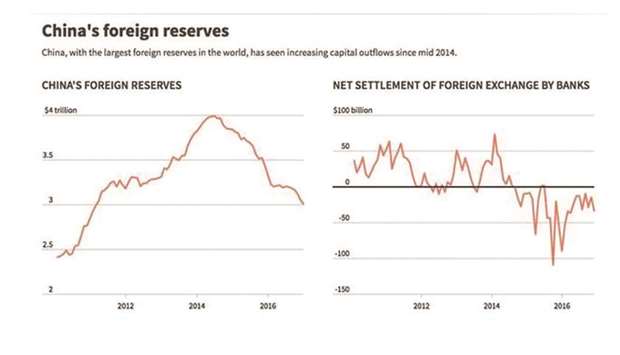Reserves rose $3.2bn during June to $3.057tn, in line with economists’ forecast in a Reuters poll.
The reserves rose by $24bn in May to $3.054tn.
It was the first time that reserves had climbed for five months in a row since June 2014, and marked its highest level in eight months.
“China’s foreign exchange reserves suggest that outflow pressures may have eased last month,” wrote Julian Evans-Pritchard, China economist at Capital Economics, adding that June could mark the first month since October 2015 in which the PBoC was a net buyer of foreign exchange.
He estimated that China’s capital outflows dropped to roughly $10bn in June from $29bn in May.
The country’s foreign exchange regulator said that the slight increase in reserves in June was driven by stronger non-dollar currencies against the greenback.
China’s foreign reserves will remain stable as cross-border capital flows become more balanced, the State Administration of Foreign Exchange (SAFE) said in a statement following the data release.
China burned through nearly $320bn of reserves last year but the yuan still fell about 6.5% against the dollar, its biggest annual drop since 1994.
Faced with an entrenched bearish yuan view, Beijing moved swiftly over the past few months to flush out speculators, quash expectations of a further steep depreciation and safeguard its reserves. That strategy to head off risks to the economy from capital outflows seems to have worked so far, with the yuan up about 2% against the dollar this year.
In May, net foreign exchange sales by the People’s Bank of China (PBoC) fell to the lowest in nearly two years as the yuan stabilised.
China also recorded a surplus in its capital and financial account in the first quarter, data from the foreign exchange regulator showed, indicating net capital inflows as policymakers tightened supervision of outflows.
However, French investment bank Natixis said in a report that its capital flow tracker for China showed outflows for the second quarter will rise to $144.1bn, reversing the trend in the first quarter.
The tighter grip on capital flows has also become a setback for China as it has been aspiring to turn the yuan into a global currency.
In an effort to reassure global investors worried about the stepped up capital control measures, China’s Premier Li Keqiang told the World Economic Forum last month that Beijing will not restrict cross-border movement of foreign firms’ earnings.
Traders said some major state-owned banks were spotted selling dollars in the market this week, a trend seen over the past few months in what analysts believe is part of official efforts to stabilise the yuan.
Still, the yuan is forecast to weaken to 7.05 per dollar in 12 months, according to a Reuters poll of more than 50 foreign exchange analysts taken in June.
The yuan is predicted to trade at 6.95 per dollar by the end of this year, compared with 7.2 per dollar forecast at the beginning of the year.
The value of gold reserves fell to $73.585bn at the end of June, from $75.004bn at end-May, data published on the People’s Bank of China website also showed.

